The birds of Upper Normandy, located in northern France, are a diverse and fascinating group of species. With its varied habitats and temperate climate, the region provides a home to many species of birds, from small songbirds to large raptors.
This region is a special place for bird lovers, as it offers a unique opportunity to observe a wide variety of species in their natural environment.
Whether you are a professional ornithologist or a novice bird-watcher, you will be sure to find something to marvel at in Upper Normandy.
1. Wood Pigeon
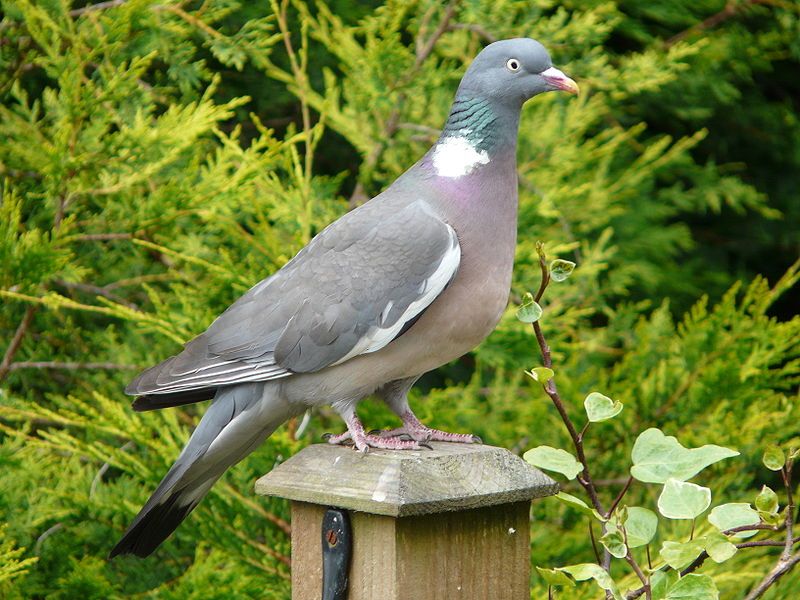
The common wood pigeon is a species in the dove and pigeon family native to the western Palearctic. It is a large bird, typically measuring around 33 cm in length with a wingspan of up to 75 cm.
It belongs to the genus Columba, which includes closely related species such as the rock dove. The common wood pigeon is generally a grey and white bird, with a white neck patch and a distinctive white wing patch.
Its diet consists mainly of grain, seeds, and fruits, which it obtains mainly from the ground. It also feeds on insects and worms. Its call is a low, repetitive “coo”, and it is a very common sight in urban areas.
The common wood pigeon is an important game bird and is widely hunted in the UK and other parts of Europe. It is also an important species for conservation, as its population is declining due to various factors such as loss of habitat and human disturbance.
| Kingdom | Animalia |
| Phylum | Chordata |
| Class | Aves |
| Order | Columbiformes |
| Family | Columbidae |
| Genus | Columba |
| Species | C. palumbus |
2. Red-Breasted Merganser
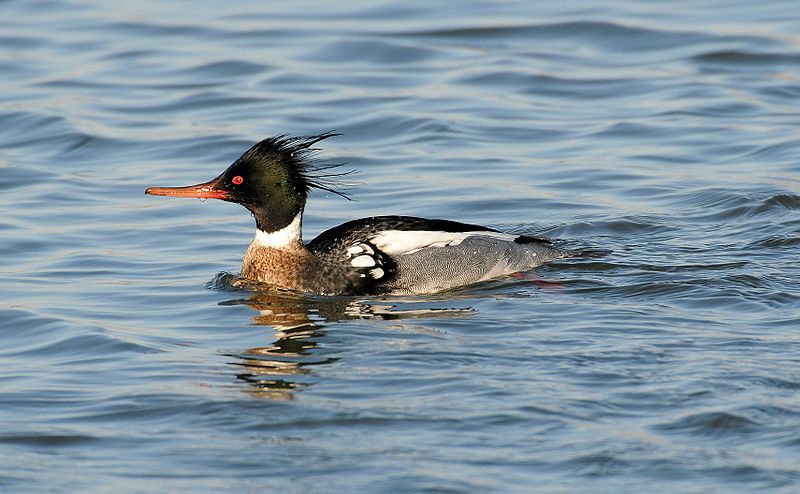
The red-breasted merganser is a species of duck that is found throughout the Northern Hemisphere. This species is easily recognizable due to its distinctive red breast, which gives it its common name.
This coloration is only displayed by males in breeding plumage, which is usually seen during the spring and summer months. The red-breasted merganser is a medium-sized duck, with a body length of around 60 cm. Its wingspan is significantly larger, measuring around 86 cm.
The male of this species is much more colorful than the female, with its red breast, white belly, and black and gray wings. The female is usually a light brown color, with a light gray head and neck.
Both the male and female of this species have a long, thin, hooked bill, which is used to forage for food. The red-breasted merganser typically feeds on fish, crustaceans, mollusks, and aquatic insects.
During the breeding season, the male will establish a territory and attract a mate by displaying his bright plumage. After mating, the female will build a nest and lay between five and ten eggs. Both parents will take part in incubating the eggs until they hatch.
The red-breasted merganser is an important part of the Northern Hemisphere’s avifauna, and has been a popular game bird for centuries.
| Kingdom | Animalia |
| Phylum | Chordata |
| Class | Aves |
| Order | Anseriformes |
| Family | Anatidae |
| Genus | Mergus |
| Species | M. serrator |
3. Common Eider
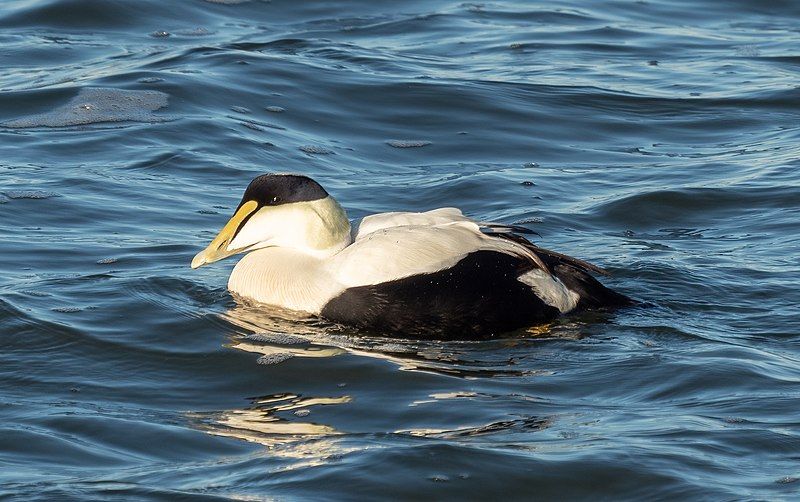
The common eider is a species of large sea duck that is found in the northern coasts of Europe, North America, and eastern Siberia. It is also known by two other names – St. Cuthbert’s duck and Cuddy’s duck.
This species is a migratory one, and it is highly valued for its exquisite, soft down feathers. The common eider is a large duck, measuring about 24-30 inches in length and weighing between 2.2 and 5.5 pounds.
The male common eiders have distinctive black and white plumage with shades of green iridescence, while females are generally brown with white and black on the head and wings. The common eider is typically found in coastal waters, bays, and estuaries.
It feeds on crustaceans, mollusks, and other marine invertebrates. The common eider is an important species for conservation and management.
It is vulnerable to human disturbances, such as hunting and fishing, as well as pollution, so its population size must be monitored in order to ensure its survival.
In addition, its down feathers are used in the production of luxury bedding and clothing, so its protection is essential to the industry.
Overall, the common eider is an important species that is widely distributed in the northern coasts of Europe, North America, and eastern Siberia. Its unique plumage and down feathers make it highly desirable for both its beauty and practical uses.
To ensure its survival, it must be protected from human disturbances and its population must be monitored.
| Kingdom | Animalia |
| Phylum | Chordata |
| Class | Aves |
| Order | Anseriformes |
| Family | Anatidae |
| Genus | Somateria |
| Species | S. mollissima |
4. Common Shelduck
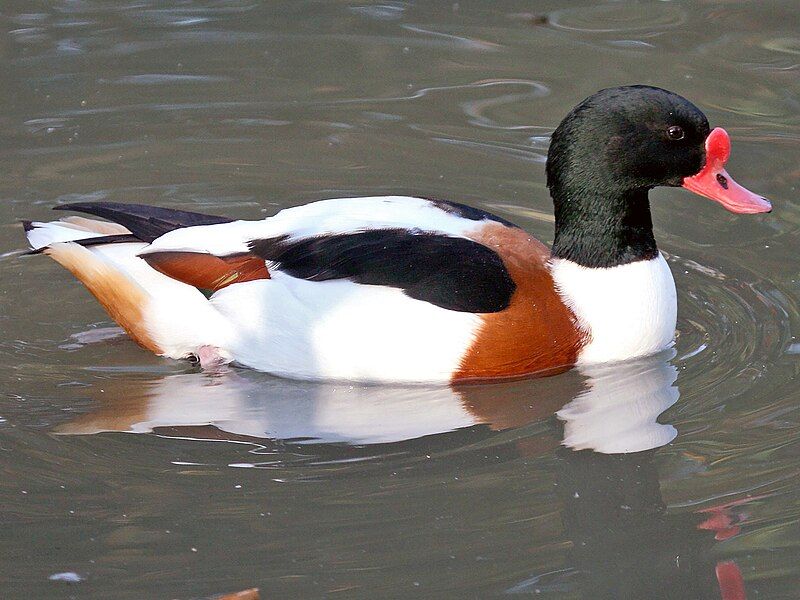
The common shelduck is a species of waterfowl that belongs to the genus Tadorna. This species is found throughout the Euro-Siberian region of the Palearctic, and is quite abundant in this region.
During the summer months, they prefer to breed in temperate climates, but during the winter they migrate to subtropical areas. Additionally, they can be seen in the Maghreb region during the winter season.
This species of shelduck is known for its distinctive plumage, which is a combination of black, white, and grey on its body, with a bright orange bill and feet.
It is a large bird with a long neck, and is usually seen in large flocks in wetlands and other areas near bodies of water.
As a result of its wide range and abundance, the common shelduck is listed as a species of least concern by the International Union for Conservation of Nature.
| Kingdom | Animalia |
| Phylum | Chordata |
| Class | Aves |
| Order | Anseriformes |
| Family | Anatidae |
| Genus | Tadorna |
| Species | T. tadorna |
5. Little Bustard
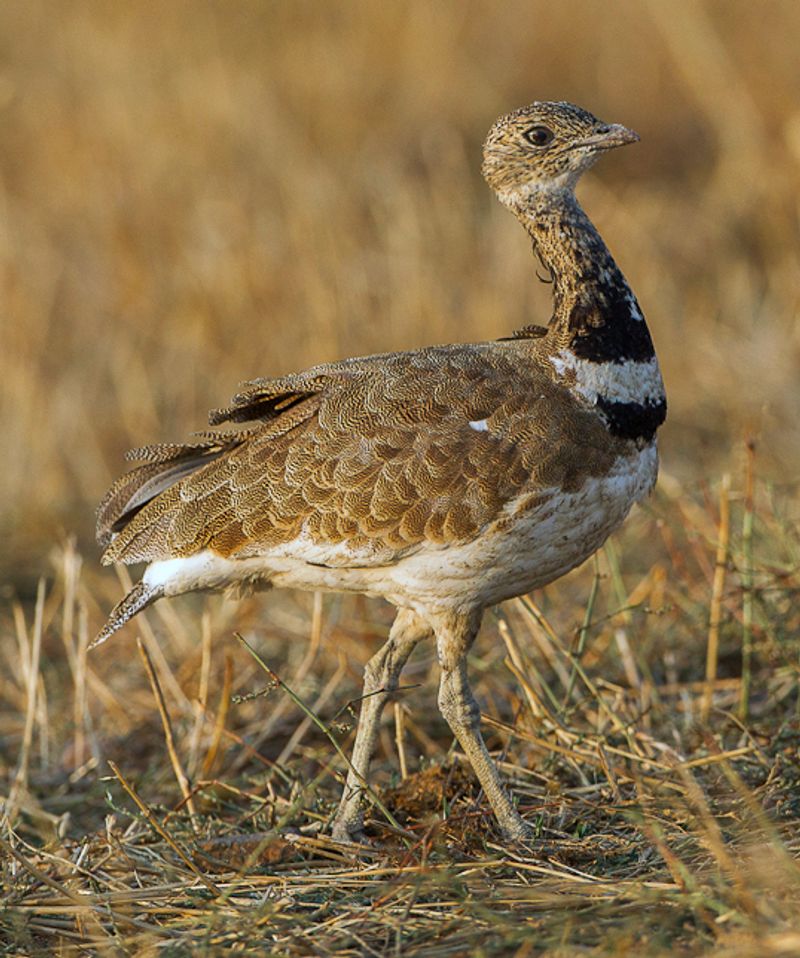
The little bustard is a species of bird that belongs to the bustard family, which is a group of large and ground-dwelling birds native to Africa, Asia, and Europe.
It is the only species in the genus Tetrax, which is derived from the Ancient Greek language and refers to a type of gamebird described by the ancient Greek playwright Aristophanes and other authors.
The little bustard is a large bird, typically measuring between 28-33 inches in length and weighing between 2-4 pounds. It is mainly brown in color, with a light cream-colored belly and darker brown and black markings on its wings.
This species is found in open grasslands, steppes, and semi-desert habitats, where it feeds on insects, small rodents, and vegetation. It is a migratory species, with the majority of birds migrating to the Mediterranean and Middle East during the winter.
During the breeding season, the little bustard is known to make loud calls to attract mates. Conservation efforts have seen a steady increase in the population of this species, but it is still classified as near threatened due to habitat loss and hunting pressure.
| Kingdom | Animalia |
| Phylum | Chordata |
| Class | Aves |
| Order | Otidiformes |
| Family | Otididae |
| Genus | Tetrax |
| Species | T. tetrax |
6. Goosander
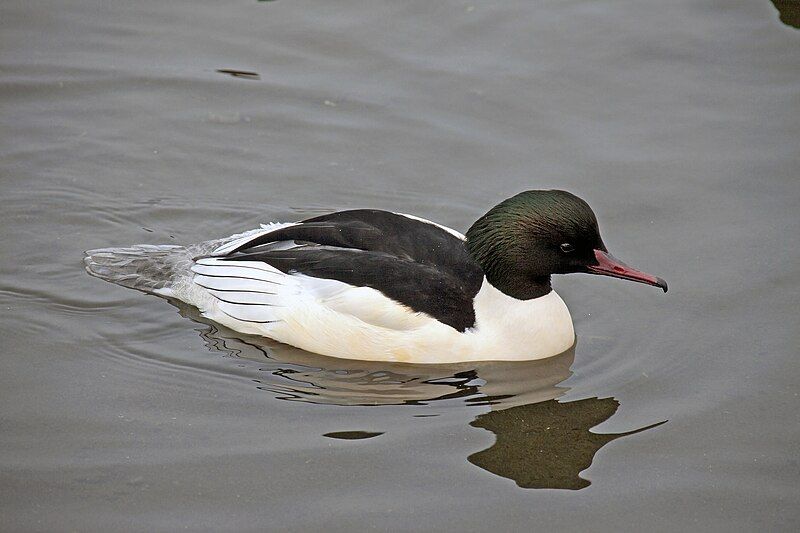
The common merganser, also known as the goosander, is a species of large seaduck found throughout Europe, Asia, and North America. These ducks generally inhabit rivers and lakes and live in heavily forested areas.
The common merganser feeds mainly on fish, as it is an adept hunter. It nests in holes in trees, usually near water sources, which helps to protect the eggs and young from predators.
The common merganser is an important part of the local ecosystems of the regions it lives in, as it helps to keep fish populations under control. As a result, it plays a key role in maintaining healthy aquatic systems.
| Kingdom | Animalia |
| Phylum | Chordata |
| Class | Aves |
| Order | Anseriformes |
| Family | Anatidae |
| Genus | Mergus |
| Species | M. merganser |
7. Eurasian Blue Tit
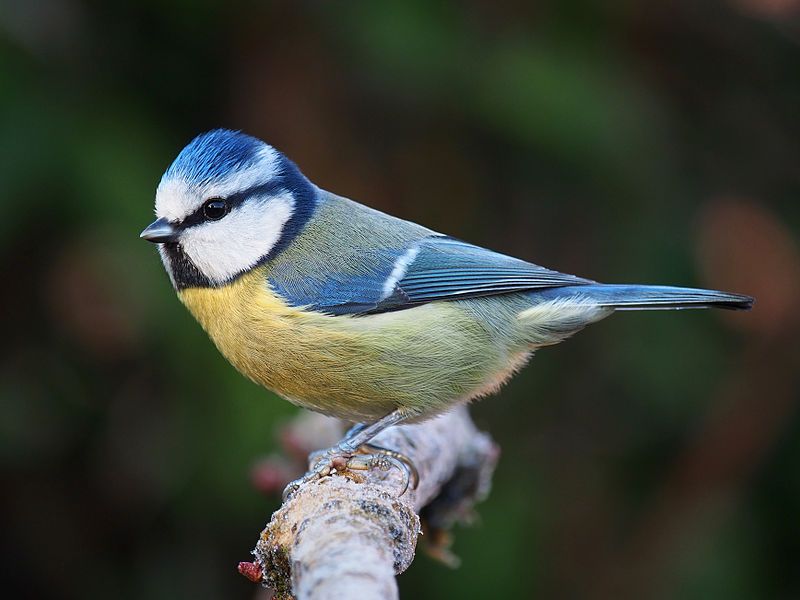
The Eurasian blue tit is a colourful bird that belongs to the Paridae family of passerines. It is a small bird that can be easily identified by its bright blue and yellow plumage.
This bird has a distinctive small size, reaching an average of 11-13 cm in length and 12-14 cm in wingspan, with a weight of 9-14 g. Its back is predominantly blue with yellow on its wings and tail, while its underside is yellow and its head is blue and white.
Its face is marked by a white patch on the forehead and a black stripe running down the cheeks to the chin. It also has a black stripe across its chest and a white stripe along its belly.
The Eurasian blue tit is a common bird that can be found in gardens, parks, woodlands, and hedgerows throughout the UK. It mainly feeds on insects, larvae, and caterpillars, but it also eats seeds and fruits.
It is a sociable bird that often forms mixed flocks with other species such as great tits and long-tailed tits. The Eurasian blue tit is a charming and cheerful bird that can bring a lot of life and colour to any garden.
| Kingdom | Animalia |
| Phylum | Chordata |
| Class | Aves |
| Order | Passeriformes |
| Family | Paridae |
| Genus | Cyanistes |
| Species | C. caeruleus |
8. Snow Goose
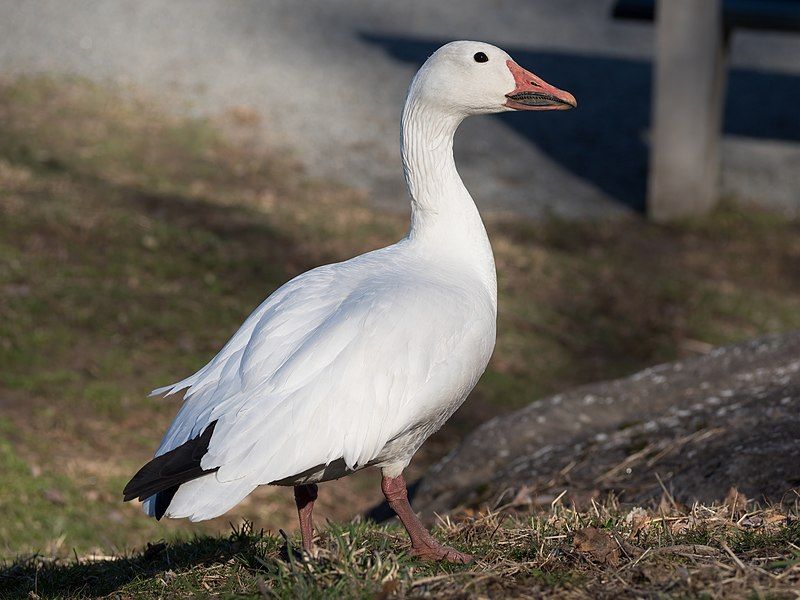
The snow goose is a species of goose native to North America. It is a type of bird that is easily recognizable due to its white plumage, which is how it gets its name. There are two morphs of the snow goose: a white one and a dark one, which is often known as the blue goose.
The snow goose has previously placed in the genus Chen, but is now typically classified in the genus Anser, which is also known as the “gray goose”.
The snow goose is a migratory bird, traveling from North America to more northern regions during the summer months and returning during the winter. It is an important species that plays an important role in the ecological balance of its native regions.
| Kingdom | Animalia |
| Phylum | Chordata |
| Class | Aves |
| Order | Anseriformes |
| Family | Anatidae |
| Genus | Anser |
| Species | A. caerulescens |
9. Barnacle Goose
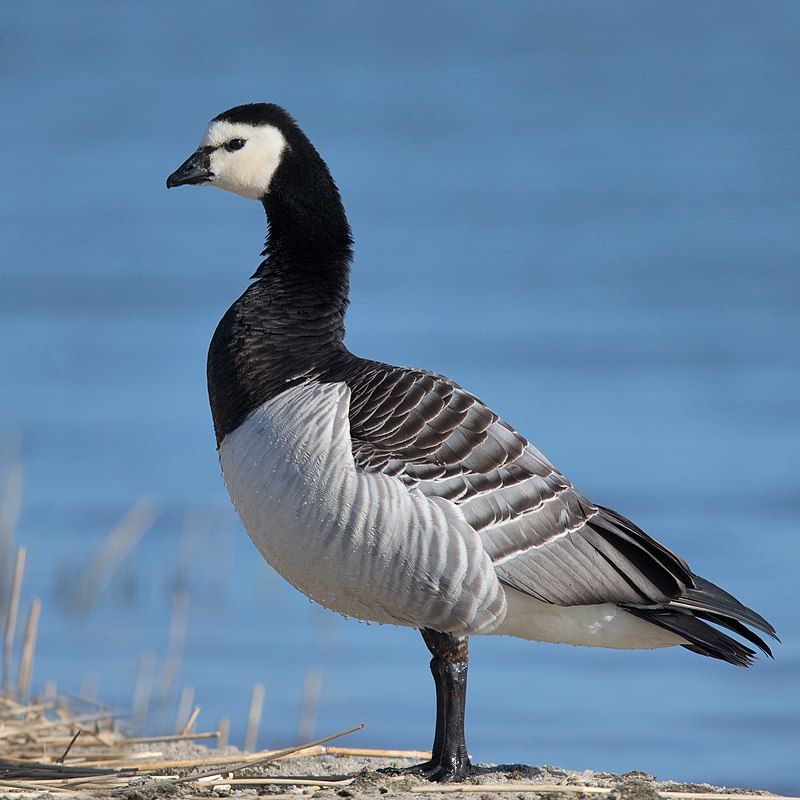
The barnacle goose is a species of goose that belongs to the Branta genus of black geese. This genus consists of species with mainly black feathers, which makes them stand out from the grey Anser species.
The Branta genus is known for its large size and distinctive features, such as long necks and dark coloration. They are also known to migrate in large flocks, often crossing large distances.
The barnacle goose is also known for its unique nesting habits, building its nest close to the shoreline. It is also known for its peculiar diet, consisting of marine invertebrates and seaweed.
The combination of their distinctive plumage and unique habits makes the barnacle goose an interesting species to observe and study.
| Kingdom | Animalia |
| Phylum | Chordata |
| Class | Aves |
| Order | Anseriformes |
| Family | Anatidae |
| Genus | Branta |
| Species | B. leucopsis |
10. Common Scoter
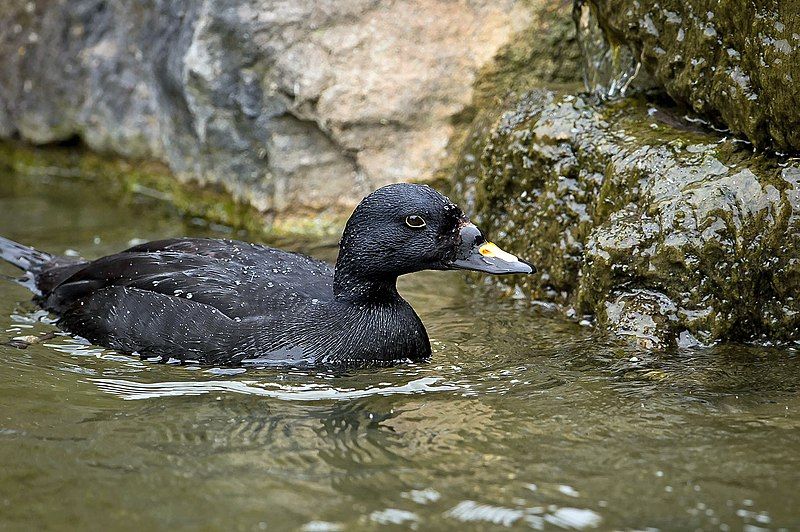
The common scoter is a large sea duck that is found in the far north of Europe and east to the Olenyok River. It is between 43 and 54 cm in length and is characterized by its black plumage.
The genus name of the duck, Melanitta, comes from Ancient Greek – ‘melas’ meaning black, and ‘netta’ meaning duck. The species name, niger, is derived from Latin and means ‘shining black’.
This species of duck is particularly unique due to its black feathers, which give the duck its scientific name. This species of duck is an important part of the ecology of the areas in which it is found, and contributes to the overall biodiversity of the region.
| Kingdom | Animalia |
| Phylum | Chordata |
| Class | Aves |
| Order | Anseriformes |
| Family | Anatidae |
| Genus | Melanitta |
| Species | M. nigra |
11. Gadwall
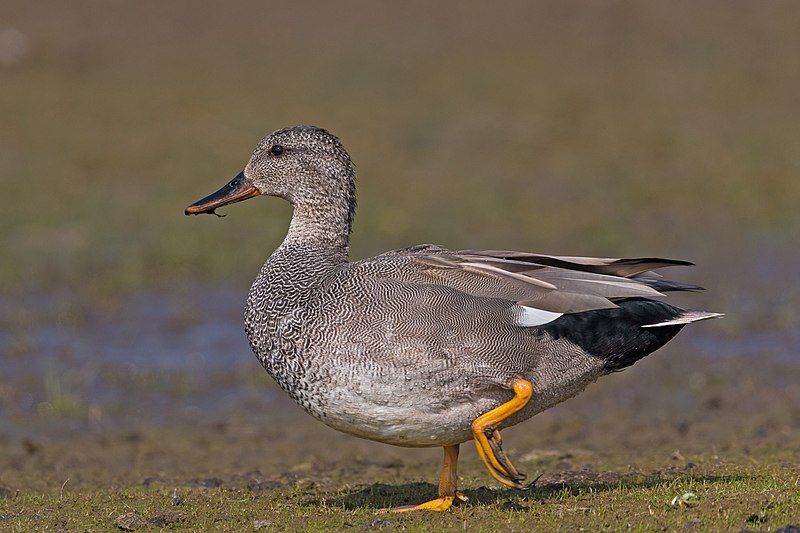
The gadwall, also known as Anas strepera, is a species of duck that belongs to the Anatidae family. This duck is a dabbling duck, which means it feeds by tipping its head underwater and upending its body to reach food.
It is native to the northern hemisphere and is found in Europe, Asia, North America, and North Africa. It is a very common and widespread duck and is found in a variety of habitats, including wetlands, lakes, ponds, rivers, and estuaries.
The gadwall is a medium-sized duck, typically measuring around 46–56 cm (18–22 in) in length and weighing about 500–900 g (1.1–2.0 lb). Its plumage is typically grey-brown on the upperparts, and white on the breast and belly. It has a dark head, white cheeks, and a dark bill.
During breeding season, the male gadwall has a white patch on the back of its head and a white band at the base of its bill. The gadwall is an omnivorous species, mainly feeding on aquatic vegetation, insects, and small crustaceans.
It is usually seen in small flocks, and is very gregarious. It is also known to form large flocks during migration.
The gadwall is a highly vocal species, producing a variety of calls, including a low growl, a chuckle, and a soft ‘kek-kek’ sound. During the breeding season, the gadwall builds its nest on the ground near water, usually in thick vegetation.
The female typically lays between 7-12 eggs, which she incubates for about 28-30 days. The chicks are precocial and leave the nest shortly after hatching. The adults are very protective of their young, and will aggressively defend their nest and chicks from predators.
| Kingdom | Animalia |
| Phylum | Chordata |
| Class | Aves |
| Order | Anseriformes |
| Family | Anatidae |
| Genus | Mareca |
| Species | M. strepera |
12. Lesser Scaup
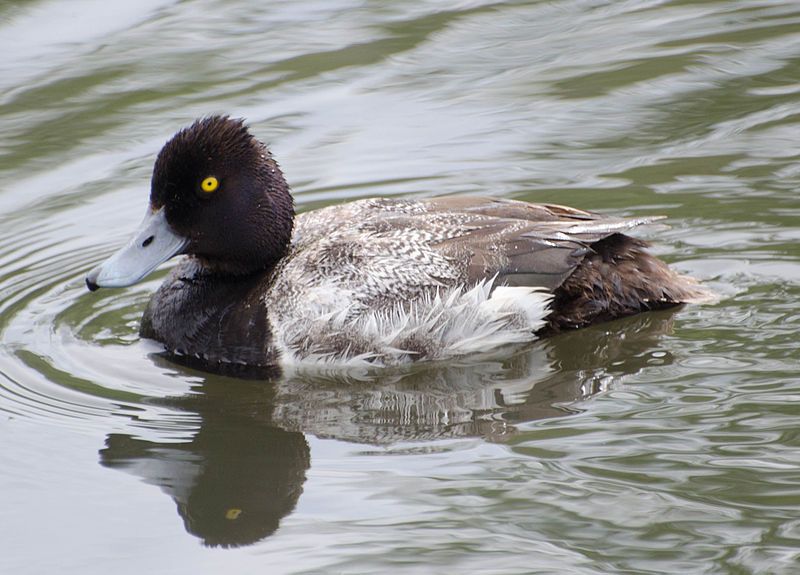
The lesser scaup is a small species of diving duck native to North America. It is also known as the little bluebill or broadbill due to its bright blue bill. During the winter months, the lesser scaup migrates southward as far as Central America.
This species of duck is a strong flyer and can travel long distances in search of suitable food and shelter. Its diet consists of small aquatic invertebrates, aquatic vegetation, and grains.
The lesser scaup prefers to breed in marshy wetlands and shallow ponds, but it will also use lakes and rivers. Once its nesting season begins, the male scaup will display a variety of courtship behaviors such as posturing and preening to attract a mate.
After mating, the female will build a nest on the ground near the water’s edge and lay a clutch of seven to ten eggs. The eggs will hatch in approximately four weeks and the ducklings will remain with the mother until they are able to fly.
The lesser scaup is a popular game bird among waterfowl hunters due to its abundance and its delicious meat. Despite this, the population of the lesser scaup has been steadily decreasing due to loss of habitat and pollution.
Conservationists are currently working to protect these ducks and their habitats in order to ensure that they will remain a part of our environment for future generations.
| Kingdom | Animalia |
| Phylum | Chordata |
| Class | Aves |
| Order | Anseriformes |
| Family | Anatidae |
| Genus | Aythya |
| Species | A. affinis |
13. Northern Pintail
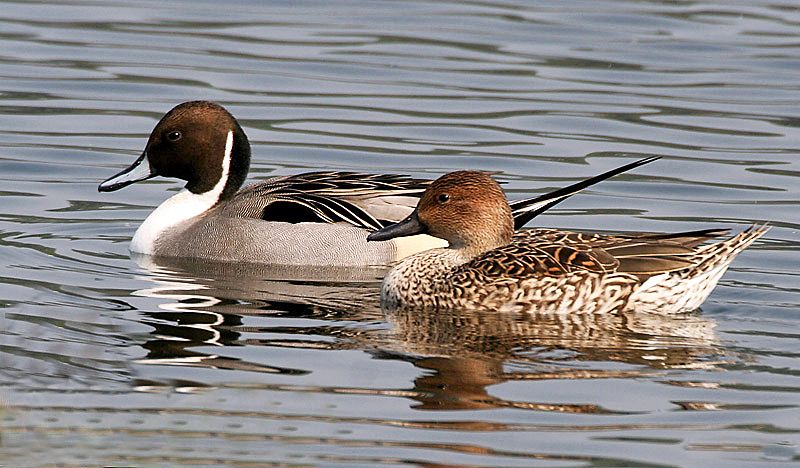
The pintail or northern pintail is a species of duck that is found in many regions around the world. It is native to northern Europe and across the Palearctic and North American regions.
It is a migratory species, meaning that it travels over long distances in search of food and favorable climates. In the winter months, it migrates south of its breeding range to regions closer to the equator.
It is believed that this species has a wide geographic distribution due to its ability to adapt to different climates and habitats. It is also known to be quite adaptable in terms of its diet, which consists of a variety of aquatic plants, insects, and small fish.
During its migration, the pintail can be observed in large flocks, soaring in the sky and gliding gracefully over the waters below.
| Kingdom | Animalia |
| Phylum | Chordata |
| Class | Aves |
| Order | Anseriformes |
| Family | Anatidae |
| Genus | Anas |
| Species | A. acuta |
14. Northern Shoveler
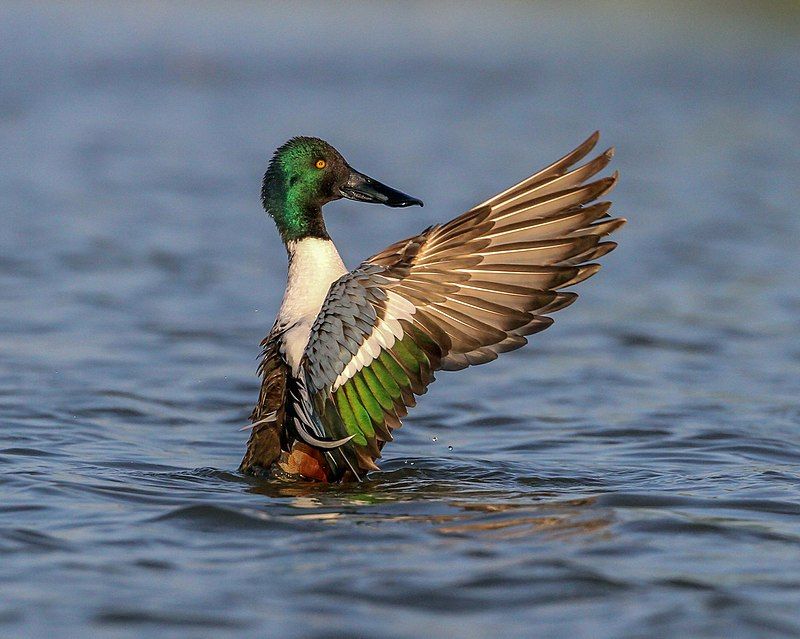
The northern shoveler is a duck species that can be found around the world. It is most commonly known as the shoveler in Britain. The species is very widespread and can be found breeding in northern parts of Europe, across the Palearctic and North America.
During the winter season, they migrate to warmer climates such as southern Europe, the Indian subcontinent, Southeast Asia, Central America, the Caribbean, and northern parts of South America.
This shows that the northern shoveler has a wide range and is able to travel great distances for survival.
| Kingdom | Animalia |
| Phylum | Chordata |
| Class | Aves |
| Order | Anseriformes |
| Family | Anatidae |
| Genus | Spatula |
| Species | S. clypeata |
15. Red-Breasted Goose
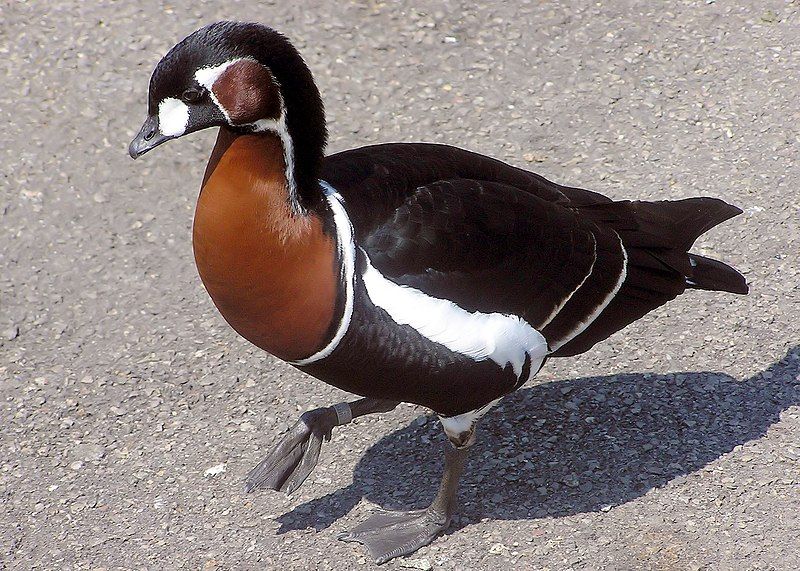
The red-breasted goose is a species of goose found in Eurasia. It is easily recognizable by its unique bright red marking on its chest, giving it its name. The red-breasted goose is classified as vulnerable by the International Union for Conservation of Nature (IUCN).
This means that the species is facing a high risk of extinction in the wild due to its declining population.
The red-breasted goose is thought to have suffered from changes in its natural habitat, such as wetland drainage and degradation, as well as human hunting and predation by non-native species.
The species is also threatened by climate change, which is creating an increasingly inhospitable environment in many parts of its range.
Conservationists are actively working to protect the red-breasted goose and its habitat, in order to ensure that this species does not go extinct in the near future.
| Kingdom | Animalia |
| Phylum | Chordata |
| Class | Aves |
| Order | Anseriformes |
| Family | Anatidae |
| Genus | Branta |
| Species | B. ruficollis |
16. Ruddy Shelduck
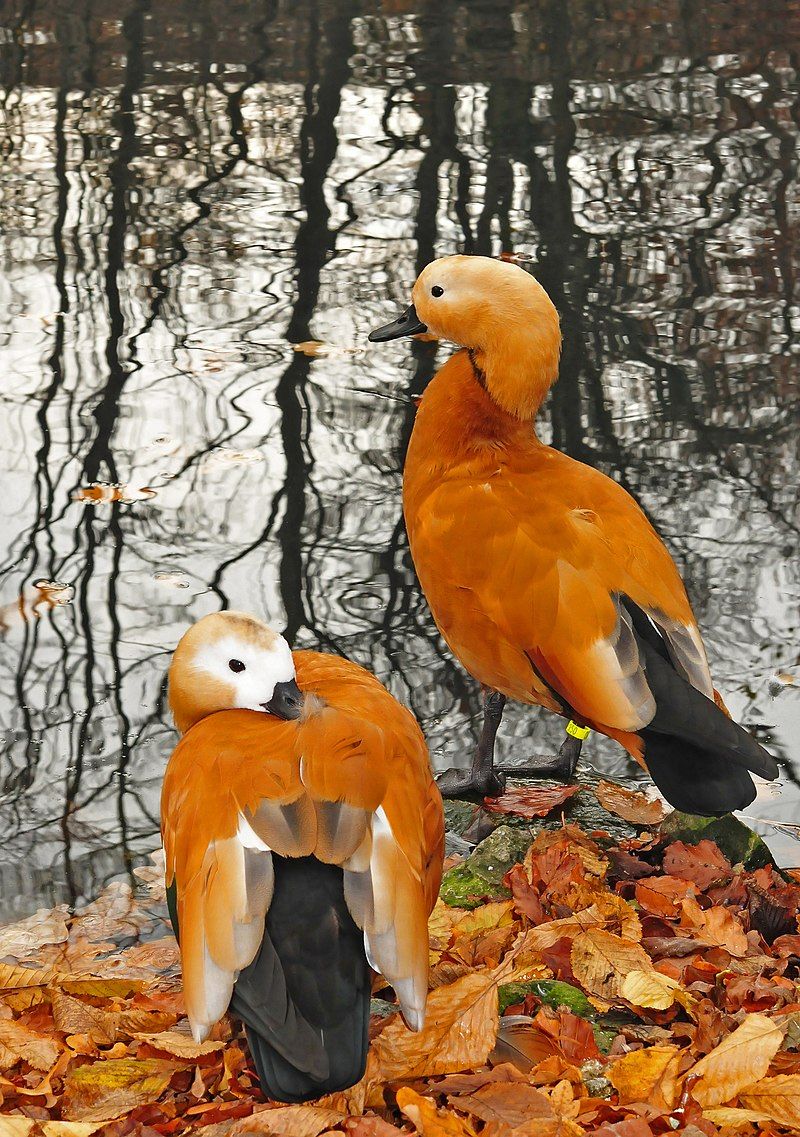
The ruddy shelduck, also known as the Brahminy duck, is a species of waterfowl that is part of the family Anatidae. It is a very unique bird, measuring between 58 and 70 centimeters in length, with a wingspan that can range from 110 to 135 centimeters.
It is a medium-sized duck, with a long, wide, and curved bill. The males and females have very different coloration, with males featuring a bright orange-red breast and head, while females have a duller, brown color. The males also have a black tail with a greenish-black sheen.
The ruddy shelduck is a distinctive bird, with a loud honking call that can be heard from far away. They are mostly found in wetlands, marshes, and lakes, as well as in agricultural fields.
They are known to migrate in large, tight flocks during the winter months, when they search for food and shelter. The diet of these birds consists mainly of plants, grains, and aquatic invertebrates.
The ruddy shelduck has a wide range, spanning from eastern Europe, to parts of Asia, including India, and parts of Africa..
| Kingdom | Animalia |
| Phylum | Chordata |
| Class | Aves |
| Order | Anseriformes |
| Family | Anatidae |
| Genus | Tadorna |
| Species | T. ferruginea |
17. White-Headed Duck
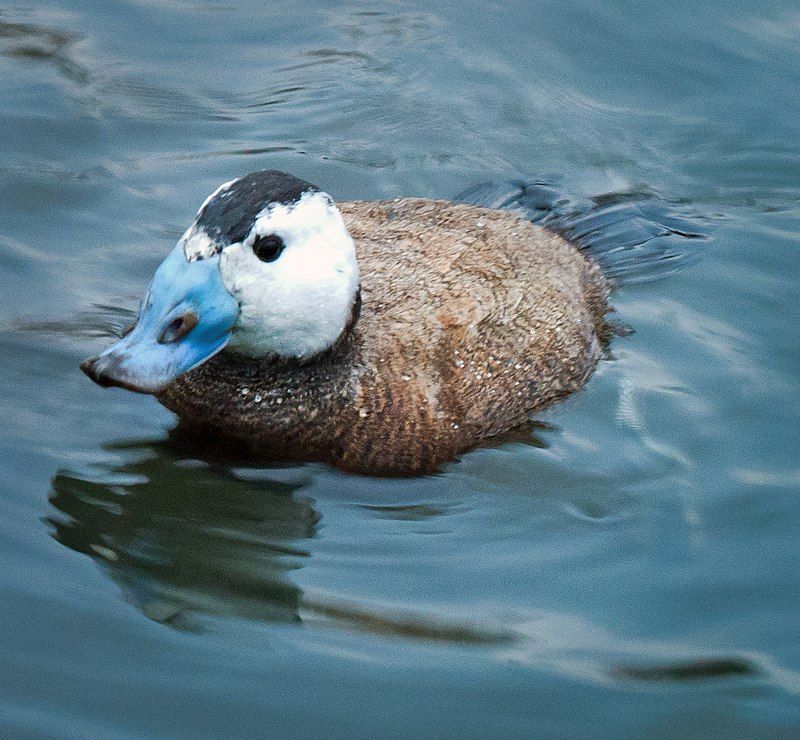
The white-headed duck is a species of small diving duck that is about 45 cm long. The male has a distinctive white head with a black crown, a blue bill, and reddish-grey plumage. The female has a dark bill and a more muted colouring.
These ducks breed in lakes that have open water and dense vegetation around the edge. The vegetation provides them with food, shelter, and protection from predators. The white-headed duck is an endangered species, and its future is uncertain.
Conservation efforts are underway to protect this species and ensure its survival. With the help of human intervention, the white-headed duck can be saved from extinction.
| Kingdom | Animalia |
| Phylum | Chordata |
| Class | Aves |
| Order | Anseriformes |
| Family | Anatidae |
| Genus | Oxyura |
| Species | O. leucocephala |
18. Greater Flamingo
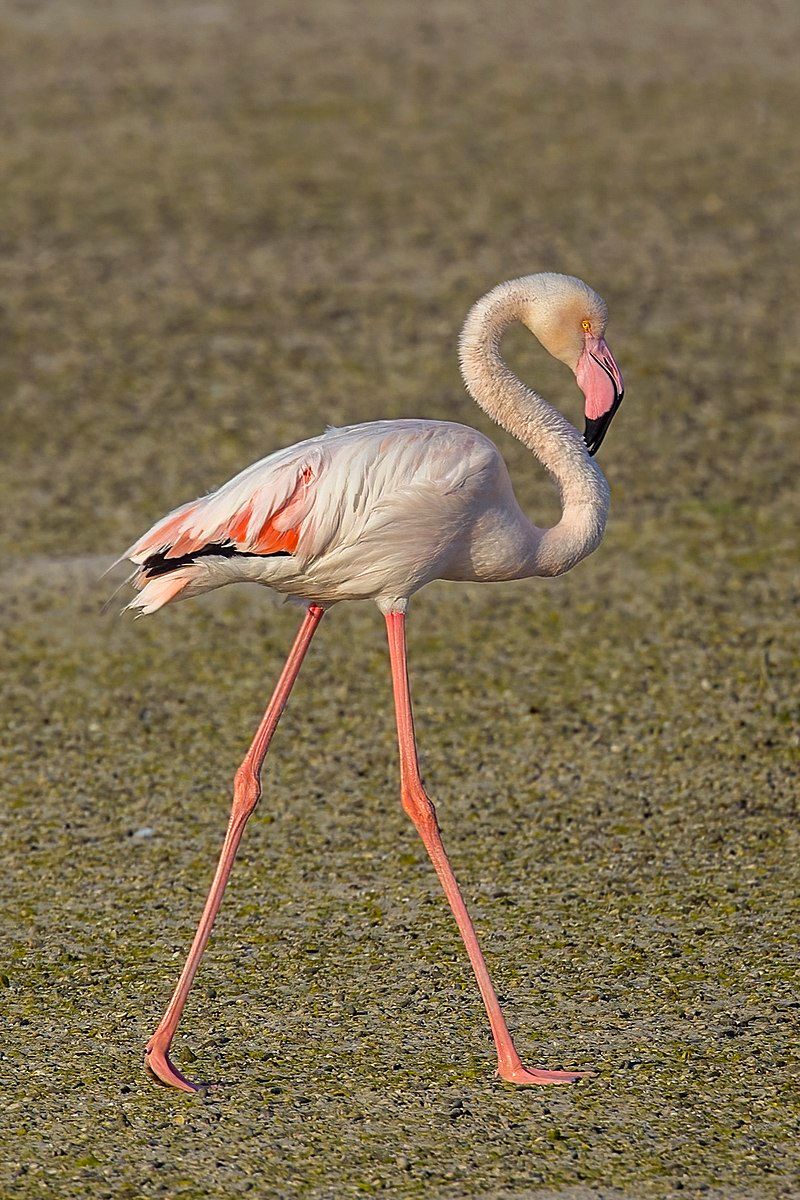
The greater flamingo is the most widespread and largest species of flamingo in the world.
They are mainly found in the Old World, which includes Northern and Sub-Saharan Africa, as well as the Indian Subcontinent, the Middle East, the Levant, the Persian Gulf, the Gulf of Aden, the Red Sea, and the Mediterranean countries of Southern Europe.
They are a common sight in these regions, and their size and impressive plumage make them a beautiful sight to behold. The greater flamingo is typically white or pink in color, with a long neck, a slender body, and long, curved legs.
They have a delicate, curved bill that is used to filter food from the water. The greater flamingo is a gregarious species and can be found in large flocks.
They feed on algae, small invertebrates, and plankton. The greater flamingo is an important species in the ecosystems it inhabits, and its presence is essential for maintaining healthy water quality and habitats.
Furthermore, the greater flamingo is an iconic species, and it is a symbol of beauty and grace. For these reasons, it is important to protect this species and its habitats.
| Kingdom | Animalia |
| Phylum | Chordata |
| Class | Aves |
| Order | Phoenicopteriformes |
| Family | Phoenicopteridae |
| Genus | Phoenicopterus |
| Species | P. roseus |
19. Great-Crested Grebe
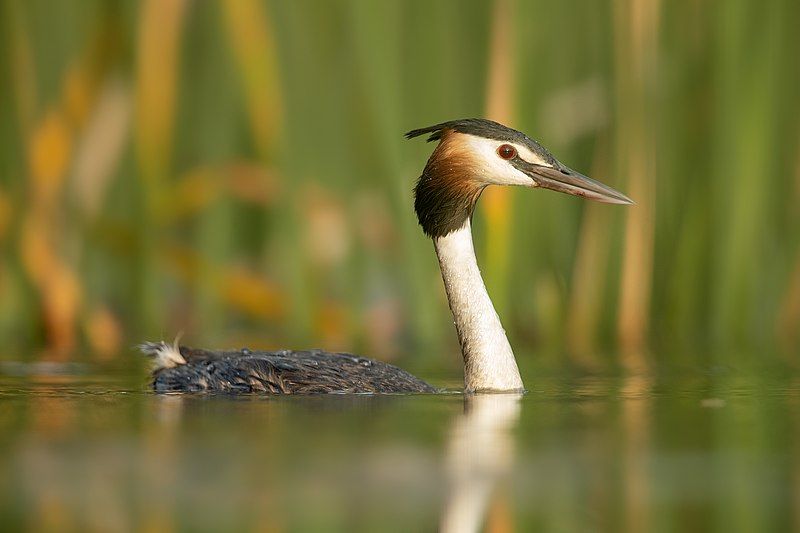
The great crested grebe is a species of water bird found throughout Europe, Asia, and Africa. It is a member of the Grebe family, which comprises 22 different species.
These birds are known for their elaborate courtship displays, which involve swimming and diving, and the male will often construct a nest to attract a mate.
The great crested grebe can often be seen in small groups near water or on the shore, where they search for food such as fish, aquatic insects, and crustaceans. Their bodies are designed for life in the water, with light feathers that keep them buoyant, webbed feet for swimming, and long, sharp beaks for catching prey.
They also possess unique adaptations for diving, such as an extra-large heart and lungs that can store oxygen for long periods underwater. During mating season, the great crested grebe puts on an impressive display.
The male will construct a floating nest from vegetation, which he presents to the female. If she is impressed, she will lay her eggs in the nest and the male will then incubate them.
The two birds then perform a courtship dance, which involves swimming in circles and making a series of calls.
This display is thought to be a form of communication, as it allows the birds to choose the right mate and also helps them to deter predators. The great crested grebe is an impressive species of water bird, and its elaborate mating display is one of its most impressive features.
By taking the time to observe these birds in their natural habitat, we can better understand the fascinating behaviors and adaptations of these remarkable creatures.
| Kingdom | Animalia |
| Phylum | Chordata |
| Class | Aves |
| Order | Podicipediformes |
| Family | Podicipedidae |
| Genus | Podiceps |
| Species | P. cristatus |
20. Red-Necked Grebe
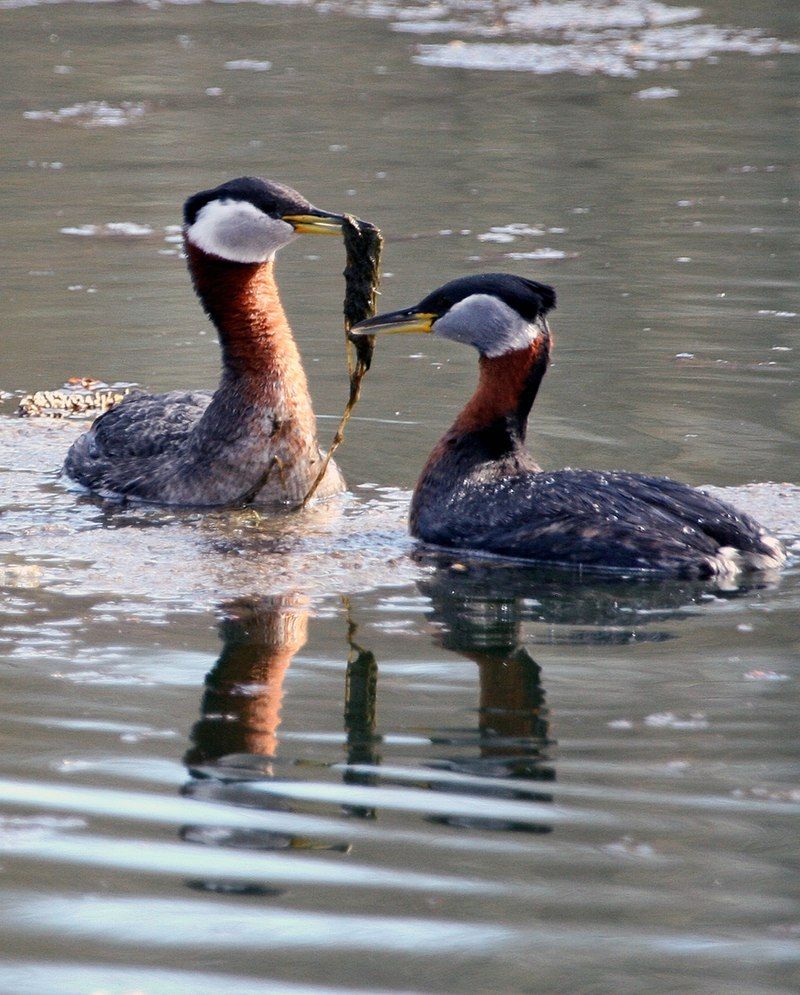
The red-necked grebe is a migratory bird species that is found in the temperate regions of the northern hemisphere. This species migrates to different areas in order to find suitable habitat for breeding and wintering.
Its wintering habitat is mainly restricted to serene waters just at the edge of the ocean, whereas some birds may winter on large lakes. The red-necked grebe is a proficient swimmer and can dive for its prey, which includes fish and aquatic invertebrates.
It has a bright red neck and black head, with a white throat and chest. During the breeding season, the red-necked grebe nests in colonies and is quite vocal, making loud honking and whistling calls.
This species plays an important role in maintaining the stability of its aquatic ecosystems, as it feeds on a variety of organisms that would otherwise overpopulate and disrupt the food chain.
| Kingdom | Animalia |
| Phylum | Chordata |
| Class | Aves |
| Order | Podicipediformes |
| Family | Podicipedidae |
| Genus | Podiceps |
| Species | P. grisegena |
21. Common Crane
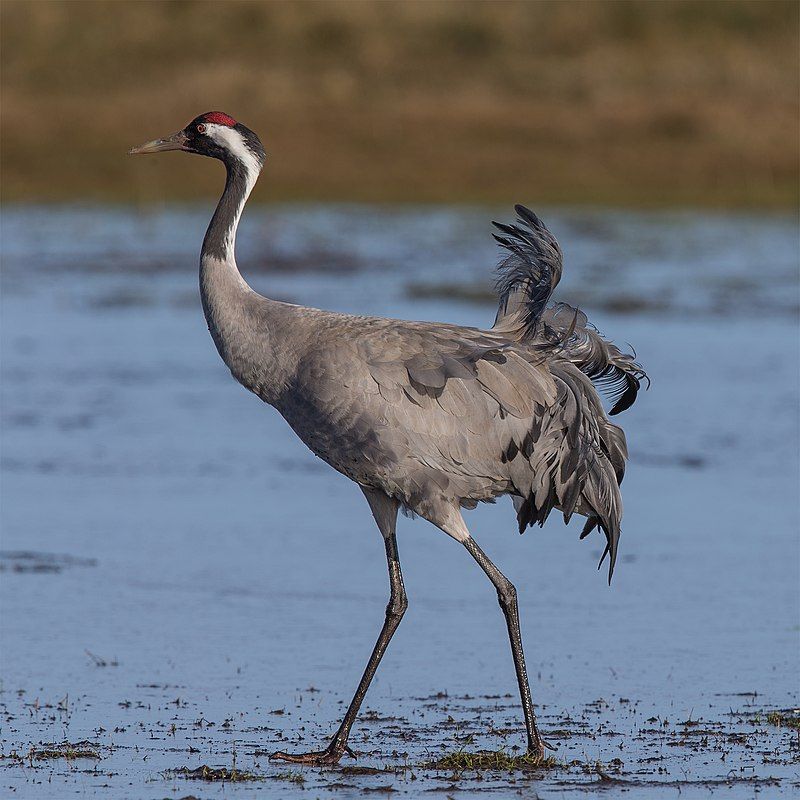
The Common Crane is a species of bird that belongs to the family Gruidae, commonly known as the cranes. It is considered to be a medium-sized species and is the only crane species that is commonly found in Europe.
The only other two crane species that are regularly found in Europe are the Demoiselle Crane and the Siberian Crane, which can only be found in the far eastern part of the continent.
The Common Crane is found throughout Europe, making it the most widespread species of crane in the region. It has a long history of being hunted for its feathers, which has resulted in a decline in its population in some areas.
Despite this, the Common Crane is still a relatively common sight in Europe. It is a sociable bird, often seen in groups or pairs, and is known for its distinctive calls.
The species is protected in many parts of Europe, and conservation efforts are helping to ensure its survival.
| Kingdom | Animalia |
| Phylum | Chordata |
| Class | Aves |
| Order | Gruiformes |
| Family | Gruidae |
| Genus | Grus |
| Species | G. grus |
22. Greylag Goose
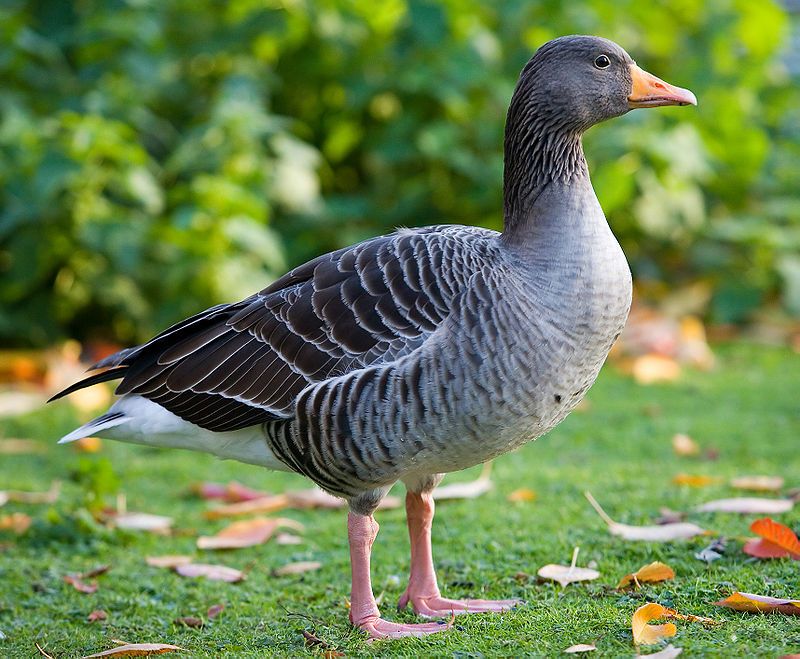
The Greylag Goose, also known as the Graylag Goose, is a species of large waterfowl in the family Anatidae. It is the type species of the genus Anser, which includes all grey geese.
These geese have mottled and barred grey and white plumage along with an orange beak and pink legs. These features distinguish it from other species of geese and make it easily identifiable.
The Greylag Goose is the largest species of wild goose in the world, with males weighing up to 7.7 pounds and females weighing up to 6.6 pounds. It has a wingspan of up to 6.2 feet and a body length of up to 30 inches.
It is a strong flyer with powerful wings that can carry it for long distances. The Greylag Goose is a migratory species and can be found in a variety of habitats, from open wetlands to grasslands and agricultural fields.
During the winter, it can be found in Europe, Central Asia and Northern Africa. In the summer, it migrates to the Arctic and sub-Arctic regions. The Greylag Goose is omnivorous, feeding on a variety of food sources such as animal matter, plant matter and grains.
It is also a social species, forming large flocks when feeding or roosting. The Greylag Goose is hunted for sport and food in many areas, and its population is threatened by habitat loss and hunting pressure.
Conservation efforts are underway to protect this species and its populations, including habitat restoration and protection of its natural habitat.
The Greylag Goose is also an important species in the culture of many countries, with its image being featured on stamps, coins and other materials.
| Kingdom | Animalia |
| Phylum | Chordata |
| Class | Aves |
| Order | Anseriformes |
| Family | Anatidae |
| Genus | Anser |
| Species | A. anser |
23. Baikal Teal
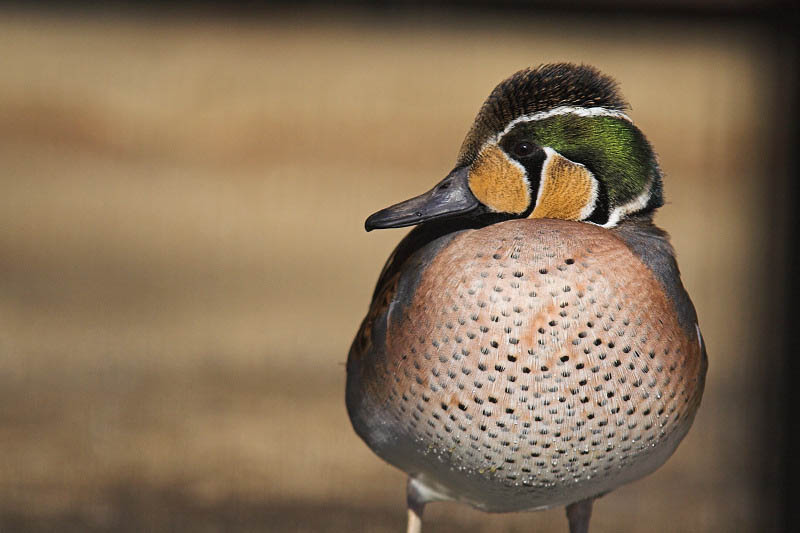
Source: Wikipedia
The Baikal teal is a species of dabbling duck that is found in eastern Russia and East Asia. It is also known by two other names, the bimaculate duck and the squawk duck. The Baikal teal breeds in eastern Russia and spends the winter in East Asia.
It is a relatively small duck, measuring between 45 and 50 cm in length. The male has a striking black and white plumage, while the female is brown with a lighter brown head. Both sexes have an orange-red bill, legs, and feet.
The Baikal teal is a freshwater species that prefers shallow, marshy areas for breeding. It feeds mainly on aquatic insects, larvae, and molluscs, supplemented with plant material such as seeds and grains.
The species is gregarious outside of the breeding season, forming large flocks of up to several hundred individuals. The Baikal teal is listed as near threatened by the IUCN due to ongoing population declines caused by hunting, habitat loss, and pollution.
Conservation efforts are underway, including the protection of critical breeding and wintering sites, as well as research into the species’ population status and ecology.
| Kingdom | Animalia |
| Phylum | Chordata |
| Class | Aves |
| Order | Anseriformes |
| Family | Anatidae |
| Genus | Sibirionetta |
| Species | S. formosa |
24. Barrow’s Goldeneye
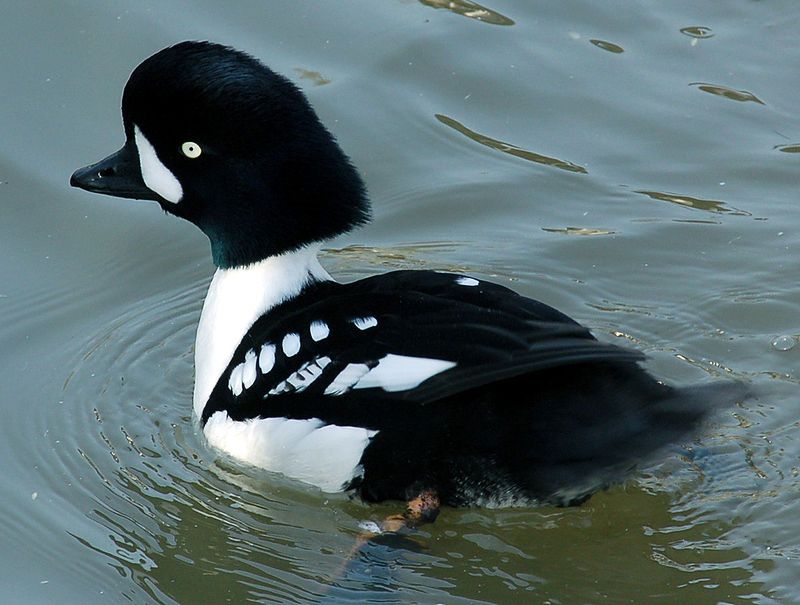
The Barrow’s goldeneye is a sea duck belonging to the Bucephala genus, also known as goldeneyes. It is named after Sir John Barrow, and its genus name is derived from Ancient Greek, “boukephalos”, which translates to “bullheaded”.
This is because the bufflehead, a species within the Bucephala genus, has a distinctive bulbous head shape similar to that of a bull. The scientific name of this species thus serves as a reference to this physical feature.
In terms of physical features, the Barrow’s goldeneye is a medium-sized sea duck that has a black back and head, with a white neck and a white patch near its eyes. The males of this species have a brownish-black chest and a bright yellowish-green patch on the upper wing.
The females are slightly duller in color, with a greyish-brown chest and a dull yellowish patch on the upper wing. This species can be found in the northern parts of North America, including Alaska, Canada, and the extreme northern parts of the United States.
They are most active during the winter months, where they can be seen swimming in the ocean or near the shore.
| Kingdom | Animalia |
| Phylum | Chordata |
| Class | Aves |
| Order | Anseriformes |
| Family | Anatidae |
| Genus | Bucephala |
| Species | B. islandica |
Conclusion
Birds of Upper Normandy are a diverse group of avian species that play an important role in the local ecology. They provide vital ecosystem services such as pest control, pollination, and seed dispersal.
They also play an important role in the cultural heritage of the region, and their presence contributes to the beauty of the landscape. Despite their importance, however, many of the birds of Upper Normandy are threatened due to habitat loss, pollution, and climate change.
It is therefore important that we take steps to protect these species and their habitats, so that they can continue to thrive and benefit us in the future.